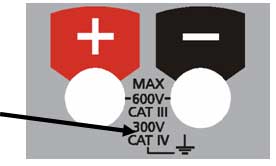The MIT300 Series Insulation Testers are rated for use on CATIV 300V applications as well as the existing CATIII 600V applications.
Why is the CAT rating important?
The CAT (Category) rating of a test instrument defines where in the electrical supply chain the instrument can be safely used. This is usually printed on the instrument across the test connections and appears as CATII, CATIII or CATIV. CATI is generally no longer used as it has no practical application.
Check Out the New Megger Insulation Testers Here
What is a CAT rating?
The CAT rating defines the level of transient (spike or surge) the instrument has been designed to withstand. These transients vary in size and duration depending on the source of the transient. The transient riding on a high-energy supply is more dangerous than a transient on an isolated cable as it can deliver larger currents when a fault occurs (a spike on steroids if you like).
A transient may be several kV in amplitude but its duration is typically very short, maybe only 50 microseconds. On its own the transient will cause little damage. However, when it occurs on top of the normal mains sinusoidal supply voltage it can start an arc, which continues until the end of the cycle. In the case of a CAT IV system the available short circuit current can be in excess of 1000 amps. This generates hundreds of kilowatts of heat in a small space for a few milliseconds, creating a big bang, possibly causing burns, fire or explosion.
Instruments designed with the correct category rating have sufficient clearance between critical parts to prevent an arc from creating the initial breakdown when a transient occurs.
IEC61010 defines the design requirements for instruments that declare a specific category rating and specifies both the electrical and physical requirements.
Recently companies such as EDF (France) have stipulated all electrical test instrumentation to be rated CATIV. This is a result of injuries sustained by engineers using inappropriately rated instruments on the supply. This is being applied to insulation testers as well as Loop testers.
Where are CATIV applications found?
The electrical supply can be broken down into categories from CATI to CATIV as shown below:
The picture shows the transmission lines (overhead or underground) as Category IV because the energy available from the supply is much higher near to the transformer. Test equipment suitable for use in this environment need to be rated to CATIV.
By the time the voltage goes through the fuse panel into the house, the circuit impedance is higher and transients are damped, reducing the available energy in the transient. The ability of the test instrument to withstand this surge is less stringent, hence a Category III rating.
The further down the supply you progress the lower the protection a test instrument has to provide. At the socket or lighting outlet the circuit is rated CATII and items such as photocopiers, televisions etc can be considered as CATI environments.
Most electricians’ testers will be rated to CATII, or the better ones to CATIII. These instruments are not designed to be used on the higher energy CATIV circuits. However in reality this does occur.
Arguably an RCD tester would never need to be CATIV due to its location in the supply chain.
Why 300V?
To achieve the same impulse withstand voltage (6kV) the working or steady state supply voltage has been reduced to 300V RMS Phase to neutral. This requires no change in the physical or electrical design of the instrument.
The 300V working (or steady state) voltage implies the instrument can be connected to a 300V single phase or 415V 3-phase supply without risk to the instrument or operator.
But an insulation tester is for dead system testing?
Absolutely, but the MIT300 can be used for voltage measurement and as such could be used for verification of supply voltage. In this application it is no different to a multimeter
Who will want CATIV?
- Electrical Utilities: – As already mentioned the electrical Utilities are now specifying CATIV instruments in an attempt to reduce risk to their operators and consequent liability, where instruments get used both inside and outside the building.
This applies to insulation testers as well as LIVE testers, as the capability to measure supply voltage exists on a voltage measurement range, as well as accidental connection to live circuits whilst in other test modes.
- Any engineer: – working outside the premise, either on overhead or underground supplies, will be working in a CATIV environment, and should be working with suitably rated instruments.
Some basic statistics:
Small transients (a few hundred volts) occur on supply systems most days of the year. Large transients (5 to 10 kV) do not occur very often. However, they are unpredictable, mostly caused by lightening strikes on overhead lines. Using a correctly rated instrument the chances of a dangerous breakdown are something like one in a million for every hour connected to the supply. Using one category less increases the chances of an accident by a factor of about 30. This means that if 100 engineers are using instruments with wrong category ratings and they connect to live systems for one hour every day, 200 days a year, a dangerous situation is likely to occur once every 18 months!
Latest posts by Mike Novello (see all)
- Used Bio-Rad Gel Doc XR For Sale - March 9, 2022
- CONSULTIX WTX-35-A4 CW Test Kit For Sale - November 9, 2021
- Biologic SP-150 Single Channel Potentiostat and VMP3B-80 Booster For Sale - September 7, 2021











